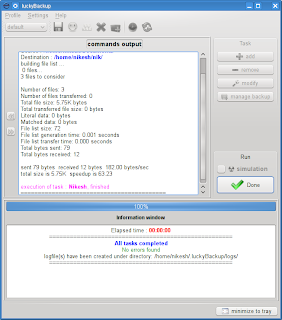Uget is a download manager that uses GTK+2 and libcurl. It allows you to classify downloads, and allows you to import downloads from HTML files. Every category has an independent configuration that can be inherited by each download in that category.
Uget has many features like : * Free (
as in freedom , also free of charge) and Open Source.
* Simple , easy-to-use and lightweight.
* Support resume download , so if your connection lost you don’t need to start from first.
* Classify downloads , and every category has independent configuration and queue.
* Queue download.
* Integrate with Firefox through Flash-got plug-in.
* Monitoring clipboard.
* Import downloads from HTML file.
* Batch download , you can download many files has same arrange , like file_1 file_2 …. file_20, you don’t need to add all links , just one link and changeable character.
* Can be used from command line.
Installation:DEB package for Debian-based distributions (Debain, Ubuntu, etc) -
hereRPM package for RPM-based distributions (RedHat, Fedora, etc) -
hereEXE for Windows XP / Vista / Win 7 , without GTK+ , you have to download
GTK+ for windows
Free, facebook, tips, Links, blogging, Downloads, Google, facebookTips, money, news, apps, Social, Media, Website, Tricks, games, Android, software, PIctures, Internet, Security, Web, codes, Review, bloggers, SAMSUNG, Worldwide, Contest, Exitic, Phones, facebookTricks, hacking, London, Olympics, SEO, Youtube, iOS, Adsense, gadgets, iPHONE, widgets, Doodle, twitter, video, Deals, technology, Aircel, Airtel, iPAD, Angry, Birds, BSNL, TechLife, GMAIL, Idea, Microsoft, SmartPhones, Stress, Buster, Windows, Yahoo, Infolinks, Nokia, Scam, Uninor, browsers, Amazon, Euro, CUP, Chat, IDM, JOBS, Modem, Music, Reliance, Results, SSC, Tata, Docomo, bing, freebie, mobile, placements, AIEEE, AlertPay, Chrome, College, Competetive, Exam, Dehradun, Extension, FireFox, GPRS, HTC, IMPACT, Info, MTS, Mark, Zukerberg, Paypal, Promotional, Post, Torrent, UTU, Unlocking, VodaFone, Wall, Paper, apple, books, engineering, iCAR, iTunes, pinterest, rovio, AVG, Admit, Card, Adobe, Affiliate, Marketing, Akhilesh, Amul, Girl, BlackBerry, ChromeBook, Clixsense, Coupon, Digitallife, Discovery, Emoticons, Festival, GATE, GIMP, Income, Tax, International, JSS, JailBreaking, Kindle, Linux, Local, MAX, PAYNE, Mac, Mango, Memory, Speed, Nexus, Online, Shopping, Raakhi, Report, Rising, Stars, Sample, Science, Sony, Syllabus, TabletBooK, Teamviewer, Templates, Dark, Knight, Rises, USA, UPMT, Virgin, Xperia, ZTE, challan, counselling, course, btech, funny, iMOVE, registration
source:http://linuxpoison.blogspot.com/2010/03/13578175714172.html








